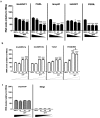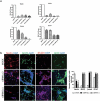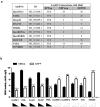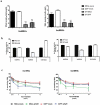HuR interacts with lincBRN1a and lincBRN1b during neuronal stem cells differentiation
- PMID: 31345103
- PMCID: PMC6779397
- DOI: 10.1080/15476286.2019.1637698
HuR interacts with lincBRN1a and lincBRN1b during neuronal stem cells differentiation
Abstract
LncRNAs play crucial roles in cellular processes and their regulatory effects in the adult brain and neural stem cells (NSCs) remain to be entirely characterized. We report that 10 lncRNAs (LincENC1, FABL, lincp21, HAUNT, PERIL, lincBRN1a, lincBRN1b, HOTTIP, TUG1 and FENDRR) are expressed during murine NSCs differentiation and interact with the RNA-binding protein ELAVL1/HuR. Furthermore, we characterize the function of two of the deregulated lncRNAs, lincBRN1a and lincBRN1b, during NSCs' differentiation. Their inhibition leads to the induction of differentiation, with a concomitant decrease in stemness and an increase in neuronal markers, indicating that they exert key functions in neuronal cells differentiation. Furthermore, we describe here that HuR regulates their half-life, suggesting their synergic role in the differentiation process. We also identify six human homologs (PANTR1, TUG1, HOTTIP, TP53COR, ELDRR and FENDRR) of the mentioned 10 lncRNAs and we report their deregulation during human iPSCs differentiation into neurons. In conclusion, our results strongly indicate a key synergic role for lncRNAs and HuR in neuronal stem cells fate.
Keywords: HuR; Neural stem cell; differentiation; long-non-coding RNA.
Figures








Similar articles
-
Long non-coding RNA FENDRR attenuates the stemness of non-small cell lung cancer cells via decreasing multidrug resistance gene 1 (MDR1) expression through competitively binding with RNA binding protein HuR.Eur J Pharmacol. 2019 Jun 15;853:345-352. doi: 10.1016/j.ejphar.2019.04.022. Epub 2019 Apr 11. Eur J Pharmacol. 2019. PMID: 30981768
-
Identification and epigenetic analysis of divergent long non-coding RNAs in multilineage differentiation of human Neural Progenitor Cells.RNA Biol. 2019 Jan;16(1):13-24. doi: 10.1080/15476286.2018.1553482. Epub 2018 Dec 27. RNA Biol. 2019. PMID: 30574830 Free PMC article.
-
Microarray expression profiling in the denervated hippocampus identifies long noncoding RNAs functionally involved in neurogenesis.BMC Mol Biol. 2017 Jun 6;18(1):15. doi: 10.1186/s12867-017-0091-2. BMC Mol Biol. 2017. PMID: 28587591 Free PMC article.
-
Uncovering the roles of long noncoding RNAs in neural development and glioma progression.Neurosci Lett. 2016 Jun 20;625:70-9. doi: 10.1016/j.neulet.2015.12.025. Epub 2015 Dec 28. Neurosci Lett. 2016. PMID: 26733304 Free PMC article. Review.
-
Regulation of neuronal-glial fate specification by long non-coding RNAs.Rev Neurosci. 2016 Jul 1;27(5):491-9. doi: 10.1515/revneuro-2015-0061. Rev Neurosci. 2016. PMID: 26943605 Review.
Cited by
-
Whole transcriptome approach to evaluate the effect of aluminium hydroxide in ovine encephalon.Sci Rep. 2020 Sep 17;10(1):15240. doi: 10.1038/s41598-020-71905-y. Sci Rep. 2020. PMID: 32943671 Free PMC article.
-
The long antisense non-coding RNA HOXA transcript at the distal tip (LncRNA HOTTIP) in health and disease: a comprehensive review and in silico analysis.Naunyn Schmiedebergs Arch Pharmacol. 2025 Jul 5. doi: 10.1007/s00210-025-04372-9. Online ahead of print. Naunyn Schmiedebergs Arch Pharmacol. 2025. PMID: 40616679 Review.
-
Neural precursors cells expanded in a 3D micro-engineered niche present enhanced therapeutic efficacy in vivo.Nanotheranostics. 2021 Jan 1;5(1):8-26. doi: 10.7150/ntno.50633. eCollection 2021. Nanotheranostics. 2021. PMID: 33391972 Free PMC article.
-
One-shot analysis of translated mammalian lncRNAs with AHARIBO.Elife. 2021 Feb 17;10:e59303. doi: 10.7554/eLife.59303. Elife. 2021. PMID: 33594971 Free PMC article.
-
Neural Precursor Cells Expanded Inside the 3D Micro-Scaffold Nichoid Present Different Non-Coding RNAs Profiles and Transcript Isoforms Expression: Possible Epigenetic Modulation by 3D Growth.Biomedicines. 2021 Aug 31;9(9):1120. doi: 10.3390/biomedicines9091120. Biomedicines. 2021. PMID: 34572306 Free PMC article.
References
-
- Temple S. Division and differentiation of isolated CNS blast cells in microculture. Nature. 1989;340(6233):471–473. - PubMed
-
- Rossi F, Cattaneo E. Opinion: neural stem cell therapy for neurological diseases: dreams and reality. Nat Rev Neurosci. 2002;3(5):401–409. - PubMed
-
- Carelli S, Giallongo T, Marfia G, et al. Exogenous adult postmortem neural precursors attenuate secondary degeneration and promote myelin sparing and functional recovery following experimental spinal cord injury. Cell Transplant. 2015;24(4):703–719. - PubMed
Publication types
MeSH terms
Substances
LinkOut - more resources
Full Text Sources
Other Literature Sources
Miscellaneous
